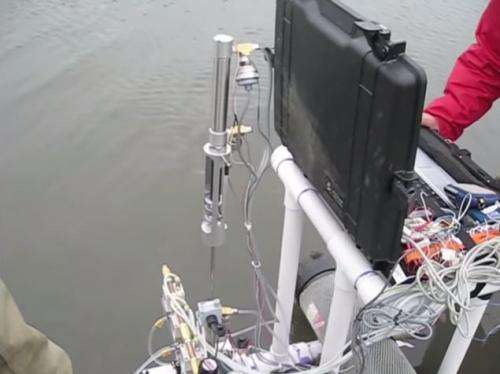'RoboClam' hits new depths as robotic digger (w/ Video)

A digging robot inspired by the unique mechanisms employed by the Atlantic razor clam has been created by a group of researchers in the US.
The robot, dubbed RoboClam, is able to dig with extreme efficiency by transforming the surrounding soil from a solid into a liquid, and could have a variety of applications from anchoring underwater robots to subsea cable installation and mine neutralization.
The first results of its performance have been published today, 9 April, in IOP Publishing's journal Bioinspiration & Biomimetics.
The Atlantic razor clam, Ensis directus, is a large species of mollusc found on the North American coast which has a remarkable ability to burrow quickly and deeply into wet sand, easily out-performing any human digger.
According to the researchers, from the Massachusetts Institute of Technology, the Atlantic razor clam should only be able to submerge itself into the soil by about 2 cm with the 10 N of force that it is able to exert. Instead, the razor clam is able to dig 70 cm into the soil.
The efficiency is achieved by the opening and closing of the clam's valves, or shells, which agitate the surrounding soil and turn it into a fluid, therefore creating less resistance and making it easier for the clam to move downwards through the soil.
The researchers have recreated the opening and closing valve mechanism of the razor clam by creating a control platform in the robot which consists of two pneumatic pistons that move a 9 cm-long effector mimicking the razor clam's valves.
The RoboClam is controlled using a "genetic algorithm", which continuously records, and then configures, a number of different variables as the robot is working. The idea is that desirable traits—in this case digging behaviours—continue to get expressed through each generation of configuration, forcing the RoboClam to evolve, just as an organism does, into an optimized digging machine.
In their study, the researchers performed over 300 tests of the RoboClam in the razor clam's natural environment in ocean mudflats off the coast of Gloucester, MA.
The results showed that the RoboClam could achieve the same fluidization of soil as the Atlantic razor clam and was able to dig into the soil nearly as efficiently.
Lead author of the research, Professor Amos Winter, of the Department of Mechanical Engineering, said: "We have demonstrated that the robot is able to burrow into the soil with the same energy and depth relationship as the animal. Moving through static soil requires burrowing energy that scales with the square of depth. By fluidizing soil and reducing drag, razor clams and the RoboClam can burrow with energy that scales linearly with depth."
"There are many applications where a small, lightweight, low-power, reversible anchor would be very valuable. At the moment we are working with an underwater robotics company, Bluefin Robotics, who produce vehicles that need to remain stationary in a current, and could therefore benefit from a small anchor."
More information: 'Razor clam to RoboClam: burrowing drag reduction mechanisms and their robotic adaptation' Winter et al 2014 Bioinspir. Biomim. 9 036009. iopscience.iop.org/1748-3190/9/3/036009/article
Journal information: Bioinspiration and Biomimetics
Provided by Institute of Physics


















